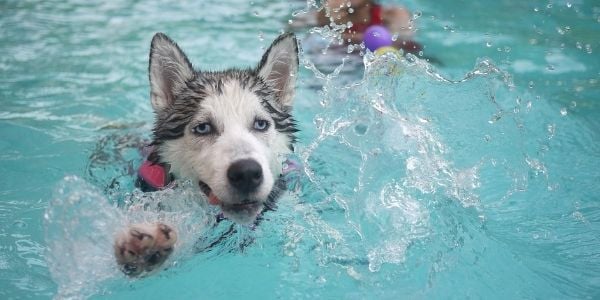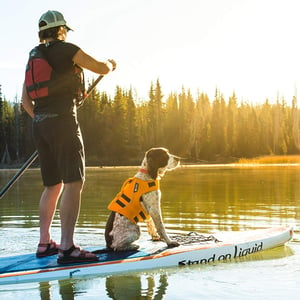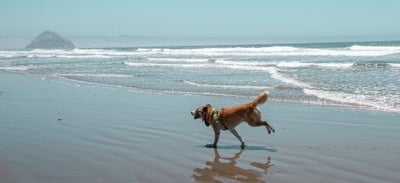 Swimming can be great exercise and entertainment for dogs that love to get in the water! From overweight or arthritic dogs that need some low-impact exercise to shed the pounds while protecting their painful joints to high-energy dogs that benefit from the extra resistance of the water in helping to wear them out, water play can provide a lot of benefits for pooches.
Swimming can be great exercise and entertainment for dogs that love to get in the water! From overweight or arthritic dogs that need some low-impact exercise to shed the pounds while protecting their painful joints to high-energy dogs that benefit from the extra resistance of the water in helping to wear them out, water play can provide a lot of benefits for pooches.
Before you throw that ball in the pool or lake, you’ll want to make sure your dog is comfortable in the water and knows how to swim.
How to Teach Your Dog to Swim
If your dog has never been around the water, take the time to slowly introduce them to it by getting in the water, too. You can start by wading into the water or standing on a step in a pool and letting your dog get acclimated to the water. If your dog starts to show interest, encourage them to join you. This may happen quickly or not at all. If your dog doesn’t show interest in the water, it’s best to try again another time.
Just because your dog is comfortable around the water doesn’t mean they’ll actually like swimming. And not all dogs are natural-born swimmers. Some dogs don’t like to swim, no matter how much we want them to. Don’t force it — try to find another form of exercise that your dog does like instead. Watch for signs that your dog enjoys swimming, like a wagging tail, ears up, or calm behavior.
Start Slow
Awesome, your pup is interested in the water! Not all dogs are natural swimmers (and some dogs have physical structure issues that make it hard to swim), so hold onto them while you encourage them deeper to see if they start to swim. Your dog may want the reassurance of you being there for a while before they are comfortable swimming on their own.
Before your dog jumps in with all paws, it’s a good idea for your dog to know some basic cues to keep them (and others) safe in the water, especially in open water like rivers or lakes. Establishing strong recall and fetch cues are important prior to letting your dog frolic in the water, as some don’t have the sense to come back to shore automatically.
 Be watchful of your dog’s energy level when playing in the water since the resistance of the water tires dogs out a lot faster than if they were playing on land.
Be watchful of your dog’s energy level when playing in the water since the resistance of the water tires dogs out a lot faster than if they were playing on land.
Pro-Tip: If your dog is far from shore and they get tired, they will sink if they don’t keep swimming. If your dog doesn’t have an off-switch (many don't) — or if they’re not a strong swimmer —you may want to invest in a doggie floatation device to help ease your worries. Life jackets allow your dog to float if they get tired or if they accidentally fall into the water. We recommend the RUFFWEAR K9 Float Coat because of its customizable fit and built-in handle.
Time to Play — Go Slow!
Now that your dog knows how to swim, it can be tempting to chuck a ball far into the water for your dog to fetch. But fetch in the water is very different from fetch on land. Just because your dog returns to you with the ball when playing fetch on land, doesn’t mean the same will happen in water. Try throwing the ball a short distance in the water and gauge your dog’s behavior. If your dog comes back with the ball a few times, try throwing it a bit further. If your dog fetches the ball and keeps swimming, you’ll need to work on the return behavior before throwing the ball very far into the water.
You can set your pup up for water fetch success by throwing things that they can easily see (think blue or yellow items) and avoiding things that sink, like rocks, which can make your dog susceptible to dry drowning (see section below).
Water Temperature ... Too Cold, or Just Right?
When your dog is playing in the water, keep the water temperature in mind since they will tire out faster the colder the water is. If your dog doesn’t have an off-switch, make sure that you’re watching their energy levels and stopping play when your dog shows the signs of exhaustion.
What to Do If Your Dog Is Suddenly In Distress
Hopefully, if you're encouraging your dog to swim, you know how to swim yourself because if your dog is in distress, you may need to go and rescue them. Remember to stay calm and assess the situation before swimming out to get your pup. To prevent more panic in your dog, you should approach your dog from the front and guide them back to shore by supporting their midsection.
If your dog is swimming in open water, including oceans or lakes, they can get caught in a rip current, dragging them away from shore. Most dogs who get caught in a rip current survive, but the humans that try and save them do not. Read our swimming safety in rivers, lakes, and oceans article for more information about rip current dangers.
Now your dog is a swimmer, here are some other things to think about when your dog is wet.
Physical Hazards Caused by Water
Drowning and near-drowning
Every year, many dogs drown or suffer from “near drowning” (a.k.a. “dry drowning”) events when they get water in their lungs while swimming and then suffer inflammation, infection, and other problems because of it a few to several days later. And it’s not just novice swimmers or those in rough oceans and lakes. Dogs get water in their lungs in ponds, lakes, rivers, oceans, and even backyard pools. Read how Sparky was saved from drowning twice in one day.
Diarrhea and dehydration
Dogs burn a lot of energy and can easily — although perhaps ironically — dehydrate while frolicking or swimming in the water. Always be sure to bring some fresh water for your dog to drink, as well as a bottle or bowl to drink from.
Overheating and sunburn
 Just like people, dogs can overheat and suffer heat exhaustion or heat stroke on hot, sunny days … even when playing in the water. Many dogs don’t have an “off switch” and will run themselves to exhaustion when in the water. You can help your pup stay safe and out of the danger zone by doing water play during the cooler parts of the day and by providing plenty of rest breaks and some shade. To protect your pup from sunburn (and skin cancer), use safe and effective sunscreens (Epi-Pet is FDA-approved for dogs) or even UV-protective dog clothes. Learn more about protecting pets from sunburn and skin cancer.
Just like people, dogs can overheat and suffer heat exhaustion or heat stroke on hot, sunny days … even when playing in the water. Many dogs don’t have an “off switch” and will run themselves to exhaustion when in the water. You can help your pup stay safe and out of the danger zone by doing water play during the cooler parts of the day and by providing plenty of rest breaks and some shade. To protect your pup from sunburn (and skin cancer), use safe and effective sunscreens (Epi-Pet is FDA-approved for dogs) or even UV-protective dog clothes. Learn more about protecting pets from sunburn and skin cancer.
Ear infections
Ear infections are, unfortunately, another very common problem for dogs that swim. It’s hard to keep water out of a dog’s ear while they’re swimming, so it’s a good idea to always clean and dry your dog’s ears after they’ve been in the water. Learn all about ear infections and what you can do to prevent them.
Hot spots
Hot spots are areas of the skin that become irritated, raw, painful, and sometimes secondarily infected, though are often well hidden under dense fur. They’re not exclusively due to swimming, but they do frequently spring up a couple of days following a swimming session (or bath). You can reduce the chance of your dog getting hot spots by completely drying them after a swimming or bathing session. Learn more about how to find hot spots and how to treat them in this article.
Dry skin
Dogs that spend a lot of time in the water might be at risk for developing dry skin and a dry, brittle coat. To minimize risks of dry skin and coat in swimming dogs, be sure to rinse your dog off after water play, especially after contact with chlorinated or seawater. Just don’t forget to dry them well after (to prevent hotspots) and also clean and dry their ears following the bath/rinse off, too!



